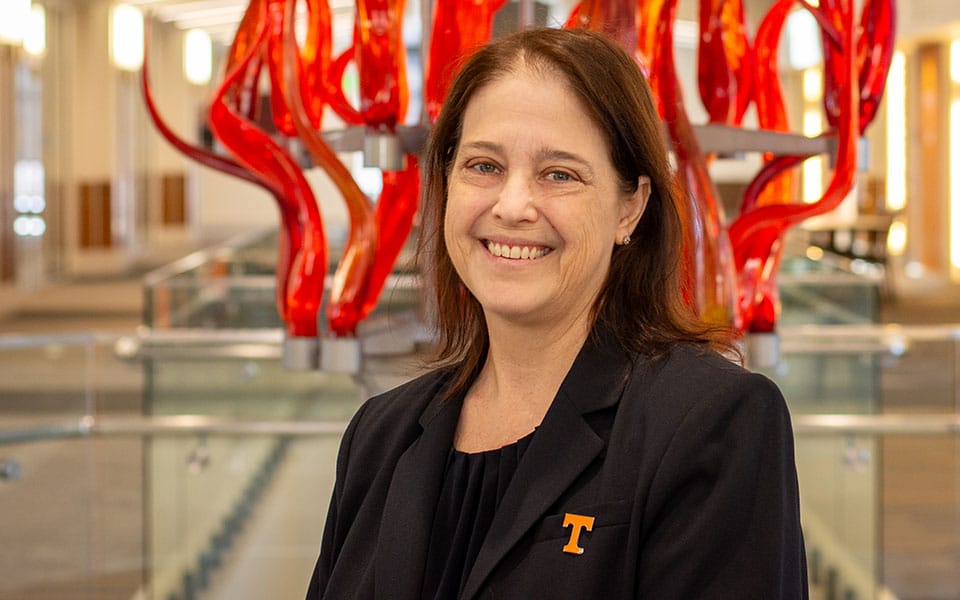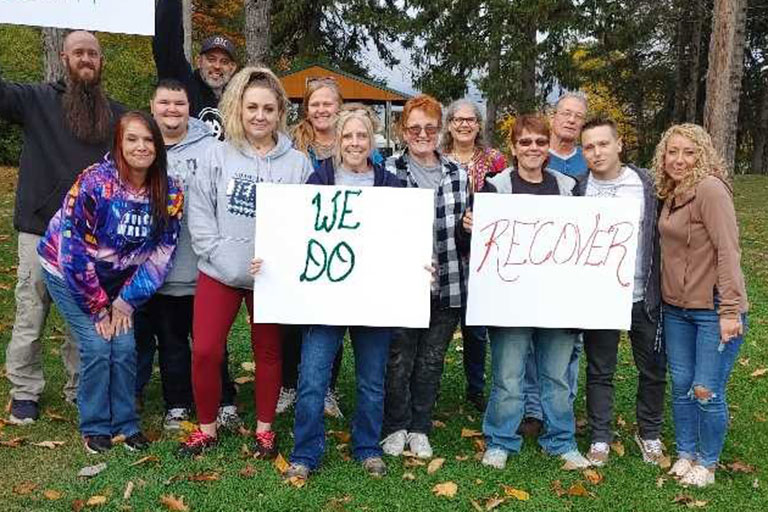Partnering with Hope
Partnering with Hope
By Laura Tenpenny (’11)
Though Bridget Freisthler had spent most of her academic career researching alcohol and cannabis use, her sister, a child welfare worker, told her that studying opioids made more sense.
“When I moved home to Ohio, it was second in the nation for opioid overdose deaths per capita—my sister was right,” says Freisthler.
Freisthler, now the Cooper-Herron Professor in Mental Health at the College of Social Work, shared this story as a presenter at the UT Grand Challenges Summit in February. This yearly conference of community leaders, state officials, and scholars from across the UT System convened to discuss the greatest concerns of the state—and fatal overdose made the list.
In 2023, Tennessee saw approximately 52 unintended overdose deaths per capita, placing it third in the United States, according to the Centers for Disease Control and Prevention. There are many efforts among participants of the summit to address this, including UT-related endeavors like the Substance Misuse and Addiction Resource for Tennessee (SMART) Initiative.

Freisthler presenting during the UT Grand Challenges Summit
Freisthler, who joined UT in June 2024, also plans to bring her substantial research from her time at the Ohio State University to bear on the topic. At the summit, she discussed the largest federally funded intervention study on opioid overdose deaths, in which she leads the Ohio research site as principal investigator.

I plan to work with academics across UT and professionals from all sectors already doing wonderful work in this area. This is not a problem that any one profession can handle alone. And that’s part of what attracted me to UT.”
Bridget Freisthler
“The HEALing (Helping to End Addiction Long-Term) Communities Study is first and foremost community engaged,” explains Freisthler. “We worked with community coalitions in Ohio, Kentucky, Massachusetts, and New York to implement interventions in rural and urban areas heavily impacted by opioid overdose deaths.
“We called it the Communities That Heal intervention, involving a three-pronged approach: data-driven decision-making to identify best evidence-based practices (EBP), partnering with communities to implement those practices, and launching a communications campaign around education and reducing stigma for persons experiencing substance use disorder.”
Community partners chose from proven practices for the needs of their area—like overdose education, distribution of naloxone for overdose reversal, and safer prescribing—to apply across behavioral health, criminal justice, and health care settings.
These sectors were pain points for many experiencing addiction. In a data-gathering effort through the platform Photovoice, one individual interpreted her court sentence as a “judgement for all” and another said the road to recovery is more like “a whirlpool” that is “sobriety-threatening.”
“That’s why sustainability was crucial to these interventions,” says Freisthler. “Six hundred fifteen practices were implemented by the 34 participating intervention communities. In Ohio early data show that over 70 percent of practices persisted.”
Naloxone distribution went up 79 percent in intervention communities, also showing a positive improvement in service provider understanding of substance use disorder and support for recovery.
“It was a really big deal to see that the college already had these connections and to know that all these groups were open to collaboration and serious about solving the problem together.”
Bridget Freisthler
“Brown County [in Ohio] was fortunate to be a part of the HEALing Communities Study—we’re thrilled with the experience and outcome,” says Deanna Vietze, executive director for Brown County Board of Mental Health and Addiction Services. “This opportunity affirmed our existing harm reduction efforts and allowed us to add several: naloxone distribution, medication for opioid use disorder EBPs, and even the purchase of a mobile van that allows us to tackle transportation issues by bringing services right into our communities.”
With the study launching in late 2019, these positive results occurred despite challenges from the COVID-19 pandemic and record levels in the drug supply of fentanyl, an opioid often combined illegally with psychostimulants like methamphetamine.
The study missed its target of a 40 percent reduction in opioid-only overdose deaths, but it did see a 37 percent reduction in overdose deaths from certain multisubstance drugs—those that combined meth or other psychostimulants (excluding cocaine) with an opioid (often fentanyl). This resembles the national landscape of addiction and overdose—including Tennessee, where drug overdose deaths in 2023 involved at least one opioid 81 percent of the time and at least one stimulant 64 percent of the time. Most often that opioid was fentanyl, which was involved in 76 percent of overdose fatalities, according to the CDC’s SUDORS dashboard.
While Freisthler wraps up the study results, she already has an eye toward how she might apply this knowledge in Tennessee.
“Our team for this study involved physicians, engineers, data scientists, social workers, public health professionals, even a geographer!” says Freisthler. “I plan to work with academics across UT and professionals from all sectors already doing wonderful work in this area. This is not a problem that any one profession can handle alone. And that’s part of what attracted me to UT.”
When Freisthler visited campus to interview, the College of Social Work brought in government officials and community leaders involved in solving the addiction and overdose challenge faced by the state.

“It was a really big deal to see that the college already had these connections and to know that all these groups were open to collaboration and serious about solving the problem together,” says Freisthler. “And the offer of a professorship assured me that there would be funding to support the work I do with study participants, even ahead of research funding. This truly allows us to accelerate our work together with the goal to reduce the problems faced by their community.
“There’s a lot of fatigue on this topic. We’ve heard about the opioid crisis, about fentanyl. We often want to tune it out. But the energy at Tennessee is refreshing, and it echoes the hope I gleaned from the study. At the end of my presentation at the summit, I shared a photo from our Photovoice project. It shows participants with lived experience of substance use disorder from one county holding up a sign. It says, ‘We do recover.’”
